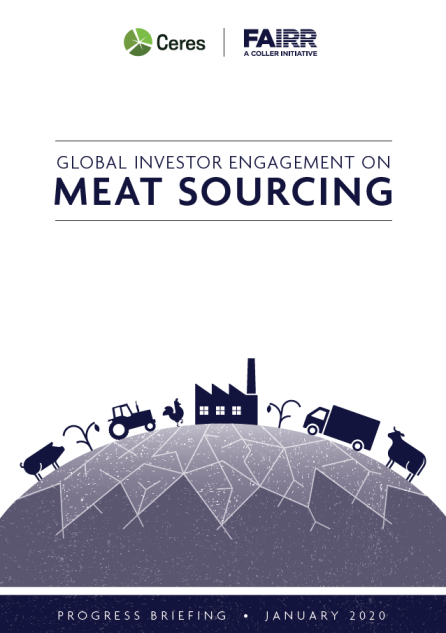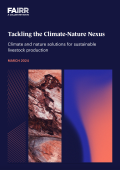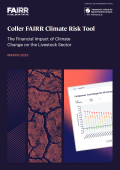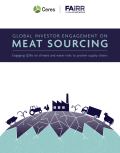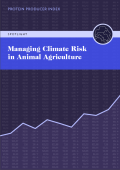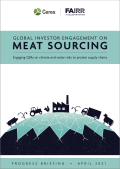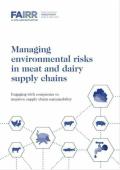Introduction
Growing global demand for meat and dairy products continues to place unsustainable burdens on our planet’s limited resources. Animal agriculture is linked to nearly 15% of global greenhouse gas (GHG) emissions and is a significant driver of both water scarcity and land-use change. As one of the largest buyers and sellers of meat and dairy products, the $570 billion global fast-food sector is increasingly vulnerable to the impacts of a warming planet on these animal protein supply chains. Multiple analyses from Ceres, FAIRR, and others have found that many prominent protein suppliers are not adequately managing these risks. In response, global investors representing more than $6.5 trillion in assets called on six of the largest fast-food companies in 2019 to act urgently to mitigate the climate and water risks in their meat and dairy supply chains.
To ensure resilient commodity supply chains, investors have requested that companies develop strong supplier policies on climate and water risks, set science-based targets to curb GHG emissions and improve water use, and perform climate-related scenario analyses to understand the risks and opportunities for their businesses. One year after launching this investor engagement, Ceres and FAIRR are excited to announce the second phase, which will continue dialogues with all six companies, with the added support of an expanded coalition of over 90 investors, amounting to a total of $11.4 trillion in combined assets under management.
90+
Investors
$11.4 trillion
in Combined Assets Under Management
Trends in Company Performance
Over the last year, investors completed an initial round of dialogues with each of these six companies. While the companies are at different stages in addressing these risks, there are some general trends that emerged from these conversations.
Investors have been encouraged by the level of company engagement, including a growing recognition of the materiality of climate and water risks in meat and dairy supply chains. However, it remains clear that companies in this sector must accelerate their efforts to set quantitative, time-bound targets and strengthen the environmental requirements that they apply to their meat and dairy suppliers. These companies have yet to conduct scenario analyses in line with the Task Force on Climate-related Financial Disclosures (TCFD) recommendations to assess the resilience of their animal protein commodity sourcing strategies against various warming scenarios.
Board oversight and management responsibilities
Boards and management have demonstrated a growing awareness of the financial materiality of sustainability risks and opportunities. All six companies are undertaking efforts to strengthen board oversight of sustainability generally.
The extent to which these efforts will result in formalized oversight over climate and water risks specific to protein supply chains remains uncertain.
Investment in staff sustainability capacity and expertise varies widely among the six companies. A lack of internal infrastructure focused on sustainability has hampered the scale of efforts to mitigate climate and water risks from protein supply chains.
Risk assessment/scenario analysis
None of the six companies have completed climate-related scenario analyses as recommended by the Task Force on Climate-related Financial Disclosures (TCFD); McDonald’s is the only company that has begun this work.
Only McDonald’s has conducted a water risk assessment of its meat and dairy value chains, though it has not publicly disclosed the findings of the assessment. RBI, however, plans to conduct a lifecycle assessment, which will include water risks for 8 high-impact categories covering over 80% of procurement spend.
Supplier policy
Several companies are communicating environmental expectations to their protein suppliers informally, but have not yet codified these expectations in policies which include specific climate and water requirements, verification mechanisms or non-compliance protocols.
Existing requirements generally remain limited to suppliers’ regulatory compliance, food safety, and animal welfare, with less emphasis on suppliers’ emissions, water and land use footprints.
Companies are engaging with industry-collaboration groups such as the Global and U.S. Roundtables on Sustainable Beef, the U.S. Roundtable on Sustainable Poultry, the Round Table on Responsible Soy and the Dairy Sustainability Alliance. While these groups have provided companies with valuable context and resources, participation in these groups has yet to catalyze the adoption of strong supplier policies or science-based emissions reduction targets from a majority of the six companies.
Targets
McDonald’s is the only company that has already set a science-based emissions reduction target, though Yum! Brands has committed to setting one.
Chipotle has stated its intention to set emissions reduction targets for its full carbon footprint.
No other company has disclosed emissions reduction targets for its supply chain, though RBI has committed to setting a target for its restaurants in Canada and the US.
None of the companies have set time-bound targets explicitly addressing the water use and pollution impacts of their animal protein supply chains.
Innovation
Some companies are piloting innovations to support emissions reduction goals. These vary from on-farm techniques (such as regenerative agriculture) to product diversification (such as plant-based menu options).
The majority of these efforts, however, appear to be in the early stages and do not constitute a robust approach to mitigate risks and capture opportunities.
See the full report for the methodology used to assess company progress.
The Case for Engagement
The fast-food sector plays a dominant role in feeding billions worldwide. In the U.S. alone, on any given day around 84.8 million adults (nearly one-third of the population) consume fast food. A significant portion of this consumption is linked to food items that wholly or partially involve meat and/or dairy products. The sector continues to expand rapidly in developing and emerging markets, especially in China where the sector is expected to experience double-digit growth up to 2025.
Across three key areas – GHG emissions, water, and land use – animal proteins have a significant environmental footprint. This footprint creates increasingly material reputational, operational and market risks for companies buying animal protein-based products.
The livestock sector is also particularly vulnerable to impacts linked to climate change. Two recent IPCC reports, “Special Report on Global Warming of 1.5°C” and “Climate Change and Land” detail the multiple ways in which climate change will directly affect animal agriculture. The impacts will include disruption through changes in feed/forage quantity and quality, poor animal health outcomes (e.g., persistent heat stress and higher incidence of disease), lower productivity (e.g., reduced milk yields and reproductive inefficiency), higher mortality and reduced water availability. The latter study is stark in its pronouncement: an average global temperature increase of 2°C would result in a decline in livestock of 7–10%, with associated economic losses of between $9.7 and $12.6 billion.
Meat processors remain behind the curve on understanding and managing these risks. The 2019 Coller FAIRR Protein Producer Index assesses 60 of the world’s largest meat, dairy and farmed fish suppliers on climate, water and deforestation risk management, finding that most fast-food suppliers have taken limited action to mitigate these risks (e.g. by setting targets or decreasing emissions). The vast majority of suppliers provide no disclosure on how they manage water use and only a few companies have sustainable agriculture policies that address water scarcity in feed farming. A large proportion provide little detail on how livestock manure is managed. This not only increases global methane emissions, but it also leads to significant impairment of local water resources.
Furthermore, analysis of companies that produce agricultural products, beverages, meat and packaged food found that the meat industry, in particular, lags considerably behind the other three in its efforts to manage risks associated with water scarcity and pollution. Meat companies are doing far less than other benchmarked companies to establish board- and executive oversight of these risks, assess risks within their operations and supply chains, and ensure supply chain resilience to droughts, floods and rising temperatures.
Areas for Improvement
Supplier Policy
Develop a supplier policy addressing the environmental impacts of animal protein sourcing.
Targets
Set quantitative, time-bound targets to reduce the impacts of a company’s animal protein supply chain.
Scenario Analysis
Undertake scenario analysis/risk assessment in line with TCFD recommendations.
Disclosure
Commit to disclosing progress towards these targets on an annual basis.
Next Steps for the Investor Coalition
Investors have been encouraged by companies’ responsiveness, their increasing recognition of climate and water risks in meat and dairy supply chains, and by meaningful efforts to mitigate such risks (disclosed throughout the dialogues). However, notable gaps in the sector’s risk management strategies remain, particularly around assessing supply chain resilience to various warming scenarios and setting time-bound, quantitative targets addressing supply chain emissions, water use, and water pollution.
In 2020, Ceres and FAIRR will work with investors to continue dialogues with all six companies with the support of over 90 investors with more than $11.4 trillion in combined assets under management.

